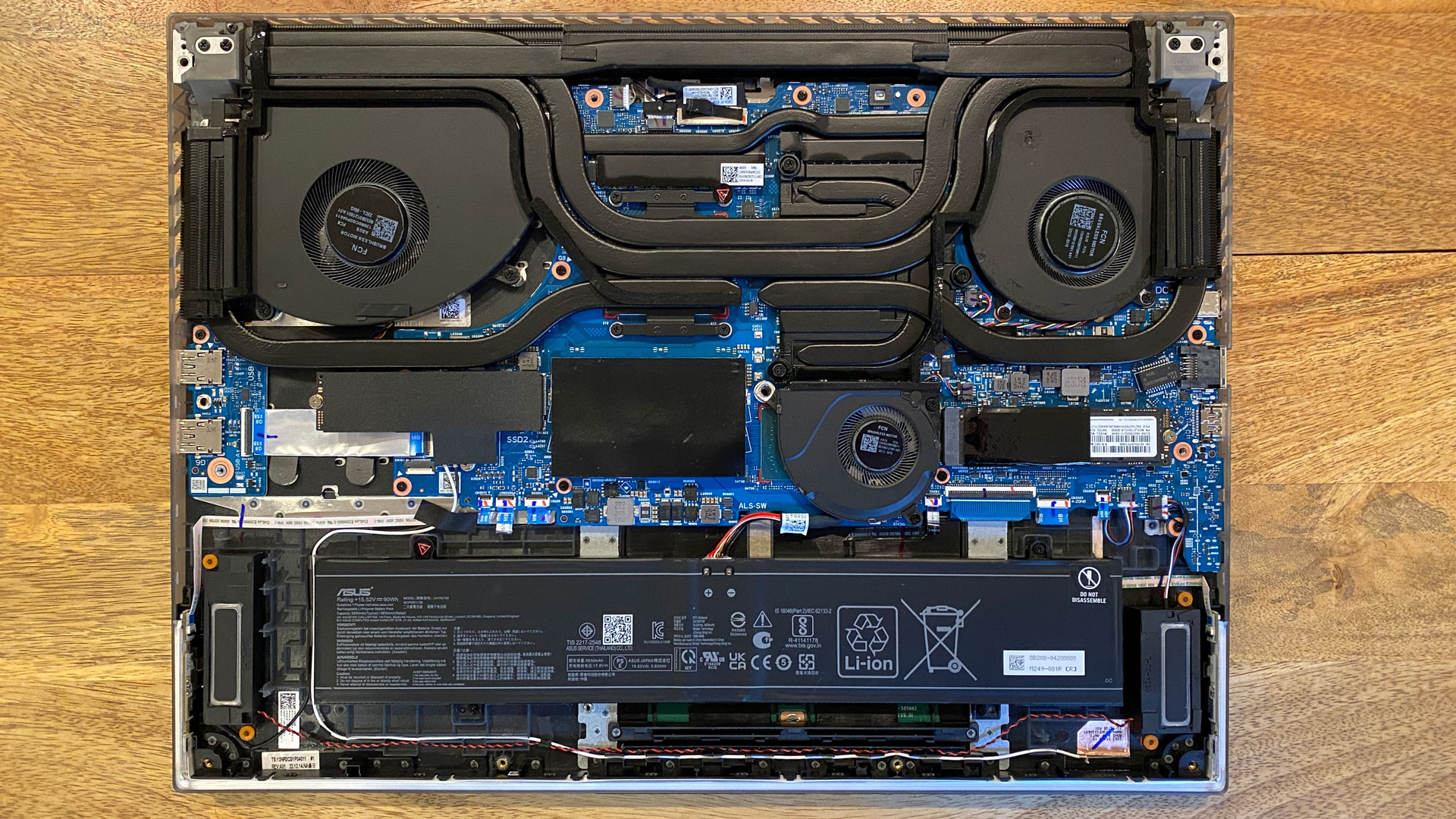Tom's Hardware Verdict
The Asus ROG Strix Scar 18 is a gargantuan gaming laptop with strong performance, a colorful display, and good speakers, for a high price. It should come with a 1080p webcam for this much money.
Pros
- +
Powerful performance
- +
Bright, colorful display
- +
Solid speakers
Cons
- -
720p webcam
- -
Very expensive
- -
Some weird keyboard layout choices
Why you can trust Tom's Hardware
Someone once said that "bigger is better." That person would probably be very pleased by the renaissance of the 18-inch gaming laptop. The Asus ROG Strix Scar 18 ($3,899.99 as tested) is one of several titanic laptops slated to arrive this year, and the to land in our testing lab.
With room for an Intel Core i9-13980HX and an Nvidia GeForce RTX 4090, the Strix Scar 18 promises top-of-the-line performance. And with a design that's absolutely smothered in RGB lights, there's no question that this is a laptop designed for gaming. (Perhaps, for some people, it will be one of the best gaming laptops.)
The Strix Scar 18 is absolutely aiming to replace your desktop. It's powerful, has a nice big display and solid speakers, and it won't last long without the power adapter. Is it enough power to please gaming enthusiasts? We'll have to see how it performs in our testing, but at least you could carry this rig from room to room.
Design of the Asus ROG Strix Scar 18
The Asus Strix Scar 18 earns the very specific honor of being the first laptop in my career that I couldn't fit in my backpack. It epitomizes the term desktop replacement for 2023, though it will be far from alone on that front.
To be fair, the Strix Scar 18 is 6.83 pounds and measures 15.71 x 11.57 x 1.21 inches. You can tell by looking at this behemoth that it's not meant to be regularly carried much further than to the next room.



There's no massive design overhaul from previous Scars here. The lid is a dark gray with the ROG logo, sporting an angry RGB eye that is, frankly, ugly. That eye pattern is repeated in a stripe diagonally across the lid. But you really get the sense of scale when you lift the lid, showing the 18-inch screen in its full glory. The bottom bezel is a bit chunky, and the casing for the webcam juts out, but that all adds to how imposing it is.
To be clear, while the 18-inch display is shocking at first, the truth is that it's not that different from the 17-inch panels on the market. These 18-inch displays change the aspect ratio from 16:9 to 16:10, meaning that they're slightly taller, but they aren't any wider than 17-inchers.
On the keyboard deck, Asus used soft-touch plastic that slowly changes from solid black to a very smoky translucent as it gets closer to the hinge, showing some of the internals. Honestly, the company should go full '90s and make the laptop shell fully translucent or clear.
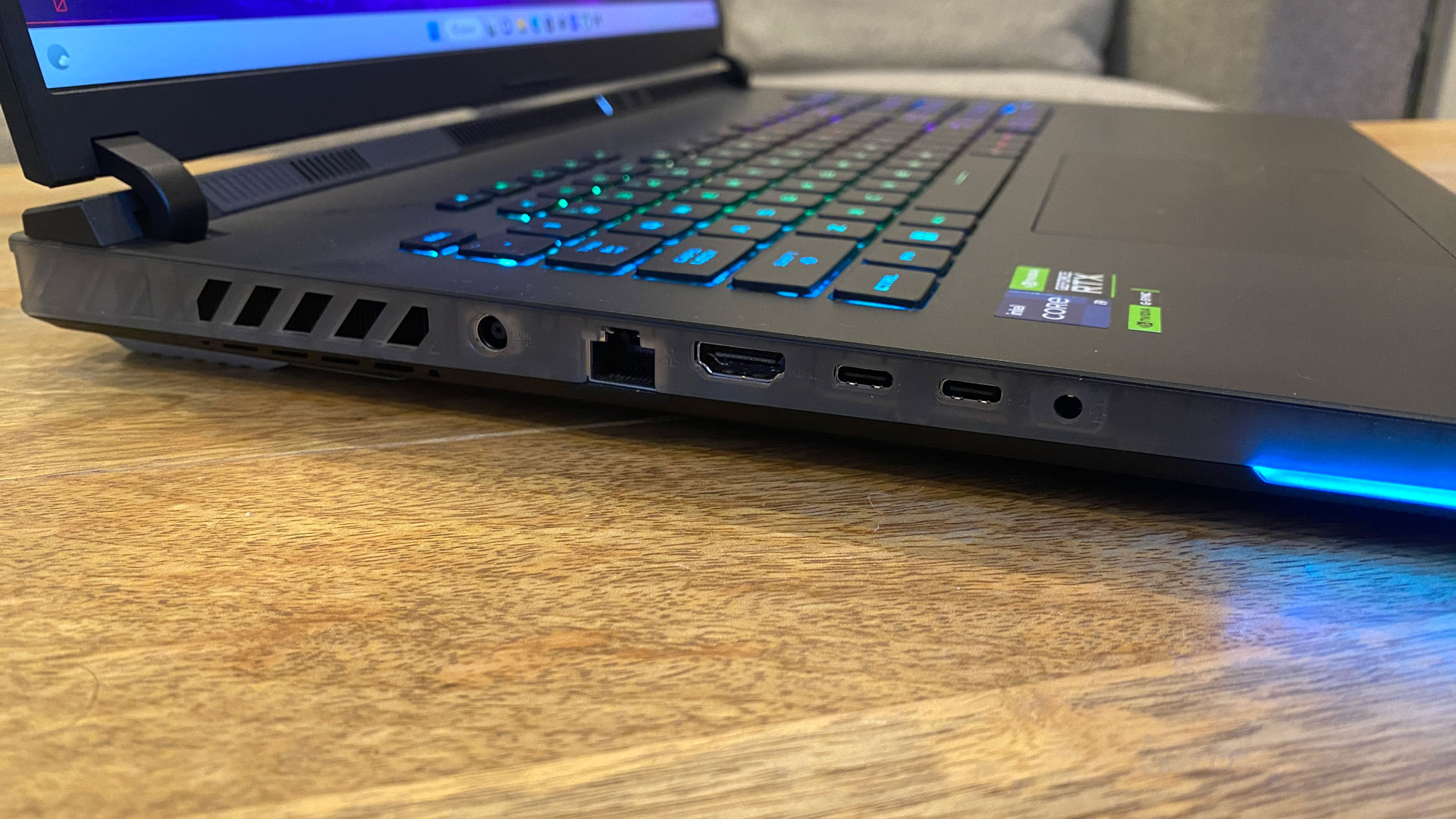

There's no massive design overhaul from previous Scars here. The lid is a dark gray with the ROG logo, sporting an angry RGB eye that is, frankly, ugly. That eye pattern is repeated in a stripe diagonally across the lid. But you really get the sense of scale when you lift the lid, showing the 18-inch screen in its full glory. The bottom bezel is a bit chunky, and the casing for the webcam juts out, but that all adds to how imposing it is.
To be clear, while the 18-inch display is shocking at first, the truth is that it's not that different from the 17-inch panels on the market. These 18-inch displays change the aspect ratio from 16:9 to 16:10, meaning that they're slightly taller, but they aren't any wider than 17-inchers.
On the keyboard deck, Asus used soft-touch plastic that slowly changes from solid black to a very smoky translucent as it gets closer to the hinge, showing some of the internals. Honestly, the company should go full '90s and make the laptop shell fully translucent or clear.
Asus ROG Strix Scar 18 Specifications
| CPU | Intel Core i9-13980HX (8 performance cores, 16 efficiency cores, 5.6 GHz max turbo) |
| Graphics | Nvidia GeForce RTX 4090 Nvidia GeForce RTX 4090 Laptop GPU (16GB GDDR6, 175W max graphics power, 2,040 MHz boost clock) |
| Memory | 32GB DDR5-4800 |
| Storage | 2x 1TB PCIe Gen 4 NVMe SSDs in RAID0 |
| Display | 18-inch, 16:10, 2560 x 1600, 240 Hz "Nebula" display |
| Networking | Intel Wi-Fi 6E AX211, Bluetooth 5.3 |
| Ports | Thunderbolt 4, USB 3.2 Gen 2 Type-C, 2x USB 3.2 Type-A, 3.5 mm headphone jack, HDMI 2.1, Ethernet jack |
| Camera | 720p |
| Battery | 90 WHr |
| Power Adapter | 330 W |
| Operating System | Windows 11 Pro |
| Dimensions (WxDxH) | 15.71 x 11.57 x 1.21 inches (399 x 294 x 23.1 mm) |
| Weight | 6.83 pounds (3.1 kg) |
| Price (as configured) | $3,899.99 |
Gaming and Graphics on the Asus ROG Strix Scar 18
The Strix Scar 18 is among the first laptops we're seeing with both the Intel Core i9-13980HX and Nvidia GeForce RTX 4090. (It's also among the first laptops we're sewing with any sort of -90 series Nvidia GPU at all, which is new for this generation of mobile GPUs.)
I wanted to see how well these components could push Control, which to this day is still my favorite example of ray tracing done right. I turned the settings as high as they went at the laptop's 2560 x 1600 native resolution. The game ran reliably over 60 frames per second, typically running between 60 and 68 fps, with a few small boosts up to the low 70's as I snuck through the Oldest House's communication departments and dodged flying objects being lobbed across the room by an object of power. In the Astral Plane, where the background is an empty white, it reliably ran over 100 fps. Dropping down to 1920 x 1200, the game ran around 100 fps, give or take a few frames, even in firefights with the hiss.



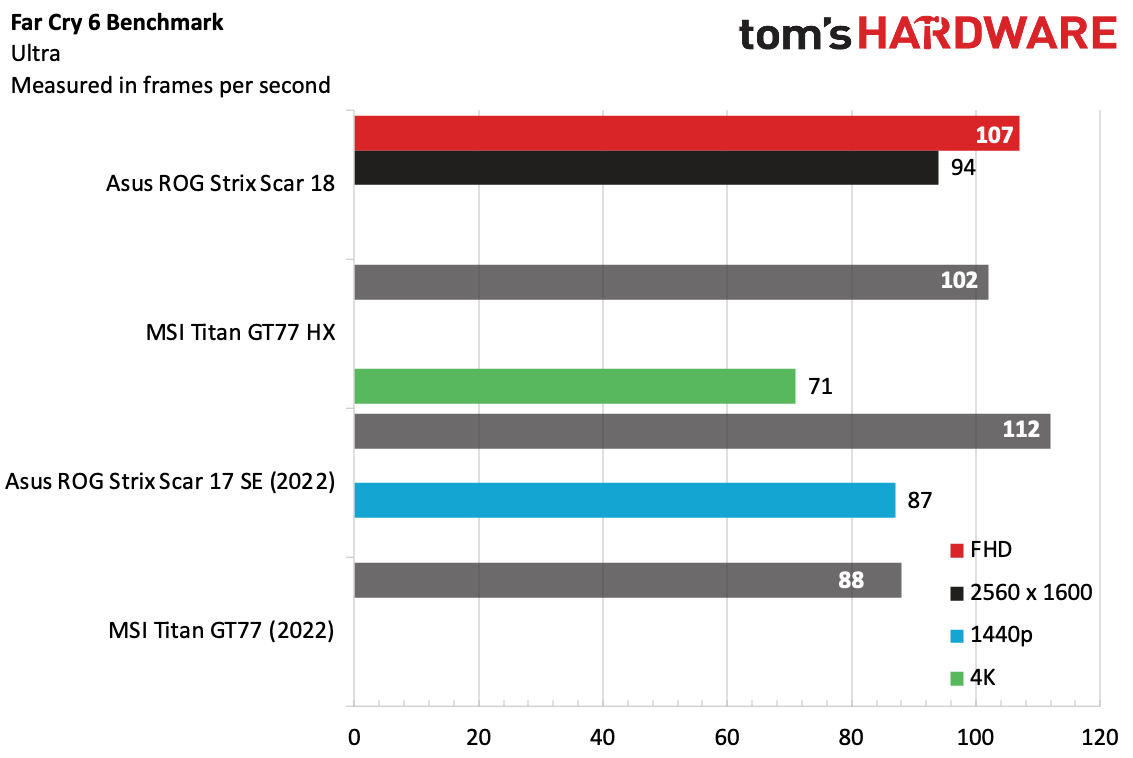
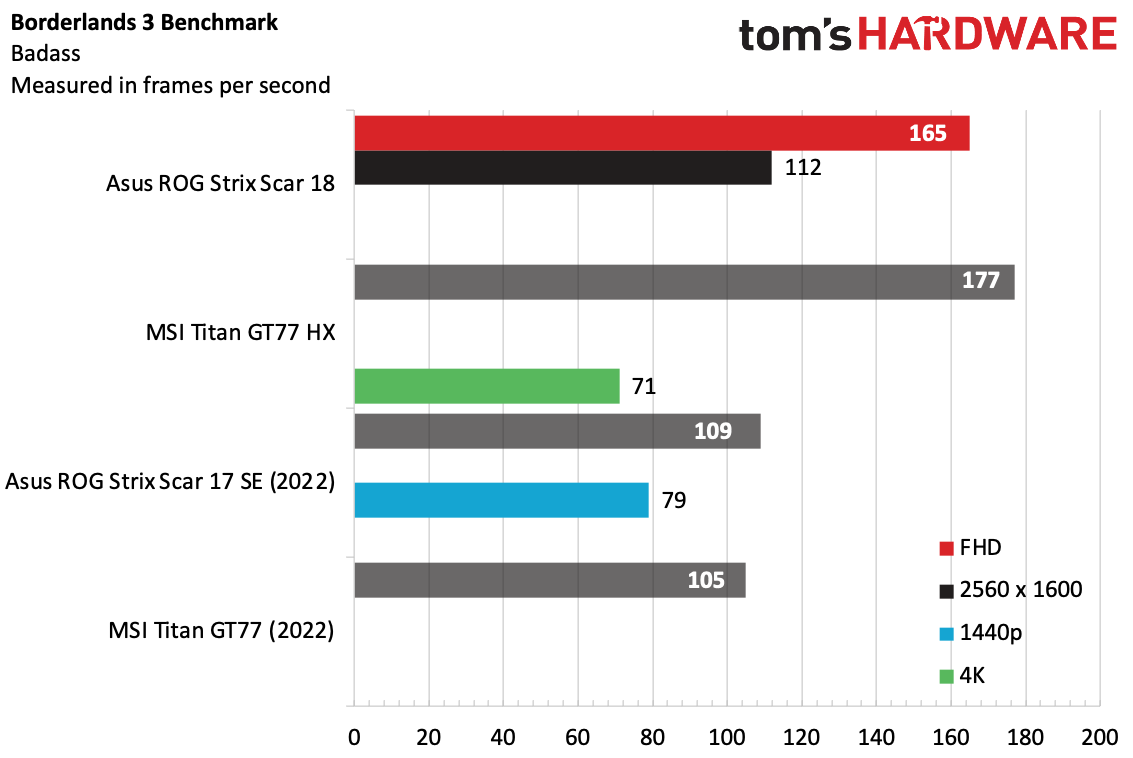
We wish we still had last year’s Strix on hand to test its 3080 Ti and Core i9-12950X with current drivers to see if it is indeed faster than the 4090 systems we’re testing here on Far Cry 6. But it seems likely that the CPU is at least somewhat bottlenecking GPU performance here at lower resolutions. We saw similar issues when testing the more powerful desktop RTX 4090 with Far Cry.
It’s easy to point the blame at Intel for potentially limiting the performance of Nvidia’s top-end mobile GPU. But keep in mind we are seeing this issue on one game. And we wouldn’t expect AMD’s best CPU to do significantly better, given what we know from testing its desktop chips. If anything, this result makes it clear that the mobile RTX 4090 is best suited to a higher-resolution 4K screen (which the MSI Titan has but this Strix Scar lacks).
Red Dead Redemption is still a punishing game. On medium settings, the Strix Scar 18 ran the game at 123 fps at 1080p and 86 fps at 1600p. MSI's newest Titan hit 128 fps at 1080p, and was playable at its native 4K at 48 fps.
On the Borderlands 3 "badass" setting, the Strix 18 averaged 165 fps at 1080p and 112 fps at 2560 x 1600. The new MSI Titan hit 177 fps at 1080p and played at 71 fps on its 4K screen.
To stress-test the Scar, we ran Metro Exodus on its RTX preset at 1080p for 15 runs, which takes about half an hour. The system ran the game at an average of 102.97 fps, which was largely consistent after a faster first run. The Core i9-13900HX's performance cores ran at an average of 3.84 GHz, while the efficiency cores measured 3.37 GHz . The CPU package measured an average 81.2 degrees Celsius. Meanwhile, the RTX 4090 ran at 2,121.62 MHz and measured 70.34 C.
Our benchmarks test results were impressive. On Shadow of the Tomb Raider (highest settings), the Strix Scar 18 ran the game at 181 fps at 1080p and 124 fps at its native 2560 x 1600. The new MSI GT77 HX Titan, with the same GPU and a Core i9-13950HX, was a single frame behind at 1080p and ran the benchmark at 70 fps on that laptop's 4K screen.
On Grand Theft Auto V (very high settings), the Strix Scar ran the benchmark at 152 fps at 1080p and 132 fps at 2560 x 1600. The Titan ran the game at 176 fps at 1080p and 50 fps at 4K.
The performance on Far Cry 6 (ultra settings) was a bit confusing, with the Strix playing at 107 fps at FHD and 94 fps at 1600p. That FHD number is less than a top-end Strix we tested last year. It’s not entirely clear if there are driver issues, a CPU bottleneck, or component compatibility problems with the game. But the MSI Titan GT77 HX with an RTX 4090 and 13th Gen Intel Core i9 HX hit 102 fps at 1080p, which isn't too far off, and 71 fps at 4K.
Get Tom's Hardware's best news and in-depth reviews, straight to your inbox.
Productivity Performance on the Asus ROG Strix Scar 18
Between an Intel Core i9-13980HX and Nvidia GeForce RTX 4090 Laptop GPU, alongside 32GB of DDR5 RAM and 2TB of SSD storage, we expected strong productivity performance out of the Scar.

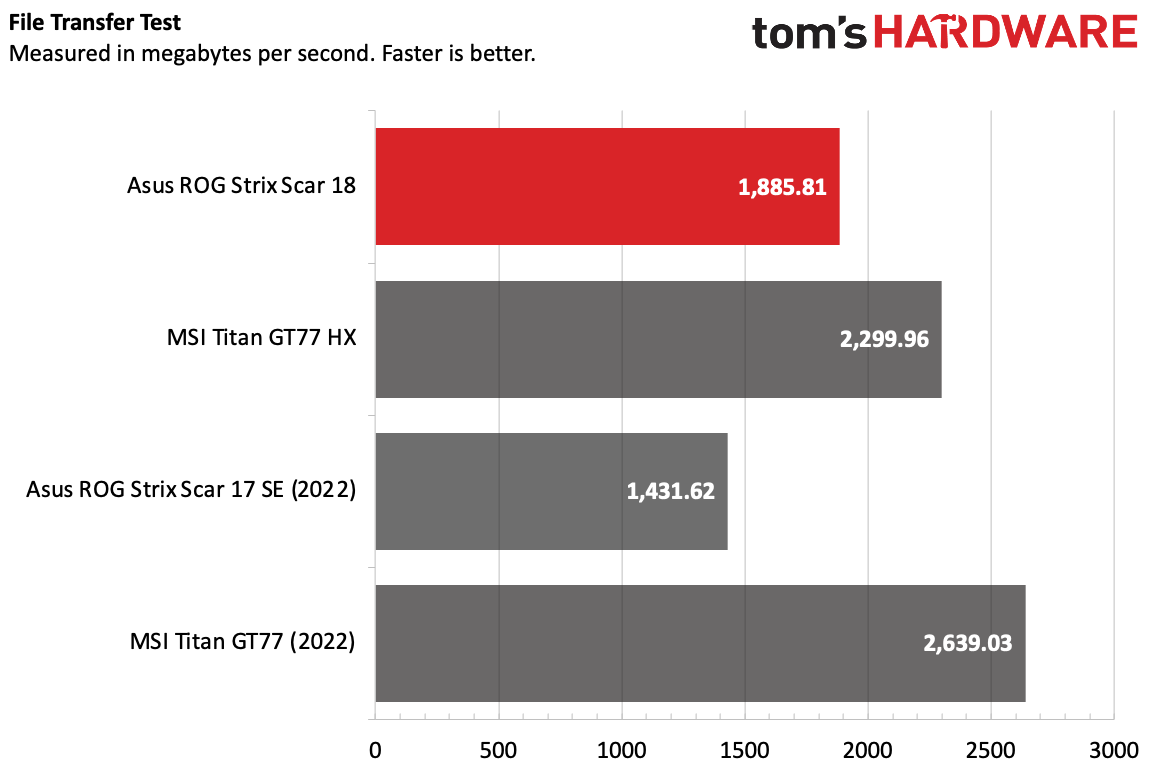

We saw gains in both single- and multi-core performance over 12th Gen Core systems on Geekbench 5 (with far more significant improvement in the latter). The Asus ROG Strix Scar 18 achieved a single-core score of 2,066 and a multi-core score of 19,233, while the MSI Titan GT77HX, with an Intel Core i9-1350HX and 64GB of RAM, saw slightly higher scores at 2,071 for single-core and 2,0602 for multi-core.
On our file transfer test, the Strix copied 25GB of files at a rate of 1,885.81 MBps, beating last year's 17-inch Strix, but was slower than the 2022 Titan. The MSI Titan GT77 HX we tested came in at a blazing 2,299.26 MBps.
We saw some improvements in Handbrake, as well. The Strix Scar 18 transcoded a 4K video to 1080p in 2 minutes and 49 seconds, beating the systems with 12th Gen chips. The new Titan came in a bit faster, at 2:38.
Display on the Asus ROG Strix Scar 18
Yeah, it's 18 inches. Asus's new panel is massive, which you may want if you're replacing an entire desktop. It has a resolution of 2560 x 1600, with a tall, 16:10 aspect ratio. Asus brands this a "Nebula" display, with support for HDR and a 240 Hz refresh rate.
The display is bright and colorful. In the short film Tears of Steel, even the darkest scenes, including one featuring a sniper on his perch, and another with a house covered in vines, were clear to see. Both lush green vegetation and neon blue and pink computer interfaces popped on the screen.
When I played Control, I was impressed by the game's reds, which are a visual motif throughout. I could still make out details in the game's darker areas, though in the Astral Plane, which is all on white, some details could get a bit blown out.
Asus' screen covers 109.4% of the sRGB color gamut and 77.5% of the DCI-P3 spectrum, falling short of the MSI Titan GT77 HX's 4K panel at 161.6% sRGB and 114.5% DCI-P3.
Keyboard and Touchpad on the Asus ROG Strix Scar 18
The keyboard on the Scar 18 offers a decent typing experience, though it has a few oddities considering the sheer width Asus had to work with.
On the monkeytype.com typing test, I hit 115 words per minute with 98% accuracy rate, which is about my usual on a good keyboard. The keys have a decent amount of click, and I didn't feel myself bottoming out as I typed. But considering the size and cost of this machine, I do wish Asus would have opted for low-profile mechanical keys, like we've seen on some Alienware and MSI machines (including the most recent Titan).
There are a few strange layout choices. The right shift key is short, seemingly to accommodate the arrow keys jammed between the QWERTY keyboard and the number pad. The up arrow is right next to that shift key, while the right arrow is jammed into the number pad area.
The touchpad, at 5.1 x 3.4 inches, is spacious. There sure is room for it. It's also nice and smooth, and I had no problem with Windows 11's most complex gestures. When you're gaming, you can turn the touchpad off with the shortcut Fn + F10.
Audio on the Asus ROG Strix Scar 18
One good thing about a massive chassis: there’s room for solid speakers. The four speakers here produce loud, detailed sound that easily filled my apartment.
While setting up the Strix, I was surprised by the detail in AJR's "The DJ Is Crying For Help," which mixes emotional violin strings with thumping bass and both pop and choral vocals. The song sounded about as clear as I've ever heard it.
Control also sounded good on the Strix, with thumping gunfire, clear vocals (the protagonist thinks aloud quite a bit in the game) and haunting atmospheric music.
The speakers support Dolby Atmos, and you can choose between some presets in the Dolby Access software. I think the "balanced" setting in music mode that comes out of the box works pretty well in a wide variety of cases, but there are also specialized settings for games, movies and voice calls.
Upgradeability of the Asus ROG Strix Scar 18
The base of the Strix Scar 18 is held in by 11 Phillips head screws. The three closest to the palm wrest are shorter than the rest, so you'll have to remember where those go. The fourth one in that spot (furthest to the right) is captive and doesn't come out.
Removing the bottom took careful prying with a guitar-pick shaped tool. I assumed, incorrectly, that the base would be held on with a ribbon cable, but the RGB lights on the bottom don't come off with the bottom. I prefer it this way, as I've seen ribbon cables attached to the bottom before, which are easy to break.
Inside, there's a ton of cooling, with loads of heatpipes to cool the CPU and GPU. There are three fans in the system, which makes sensegiven how loud it can get.
There are two PCIe SSD slots (both were filled in our unit), and the RAM and Wi-Fi card can be removed and replaced as well. All of those components are under heat-protective coverings. The battery can also be removed and replaced. I'm surprised that Asus didn't go with a bigger 99 WHr battery, looking at the internals: There's some empty space around the 90 WHr one that the Strix ships with.
Battery Life on the Asus ROG Strix Scar 18
The battery on the ROG Strix Scar 18 feels like a formality. I mean, how much are you really going to move this, aside from room to room?
I hope not much. The Scar lasted only 4 hours and 26 minutes on our battery test, which browses the web, streams videos and runs OpenGL tests, all while connected to Wi-Fi with the display set to 150 nits.
The MSI Titan GT77 HX lasted 3:48 on a charge, which is to say, this is just the type of battery life you should probably expect from these massive laptops with power-hungry components.
So yeah, when you move the Scar around, bring the power connector. You'll need it for gaming anyway.
Heat on the Asus ROG Strix Scar 18
When you play games on the Asus ROG Strix Scar 18, the fans spin up loud. That's what it takes to cool the most powerful laptop components on the market now. The question is, do you feel the heat? You very well may.
I measured skin temperatures while running our Metro Exodus stress test, and found that the center of the keyboard measured 33.5 degrees Celsius (92.3 degrees Fahrenheit), while the touchpad, which most gamers will be resting their wrists on, was a cooler 26 C (78.8 F). These are all perfectly reasonable considering the parts inside.
The bottom of the laptop gets pretty hot, reaching 50.2 C (122.36 F). But considering this laptop is too big to realistically use on your lap, it should be OK. Just be sure to keep it firmly on a table or desk.
Webcam on the Asus ROG Strix Scar 18
Resolution and image quality don't always strictly go hand-in-hand, but higher resolution usually helps. It's a shame that in 2023, Asus has a $3,700, 18-inch laptop with a 720p webcam. It's time to move to 1080p.
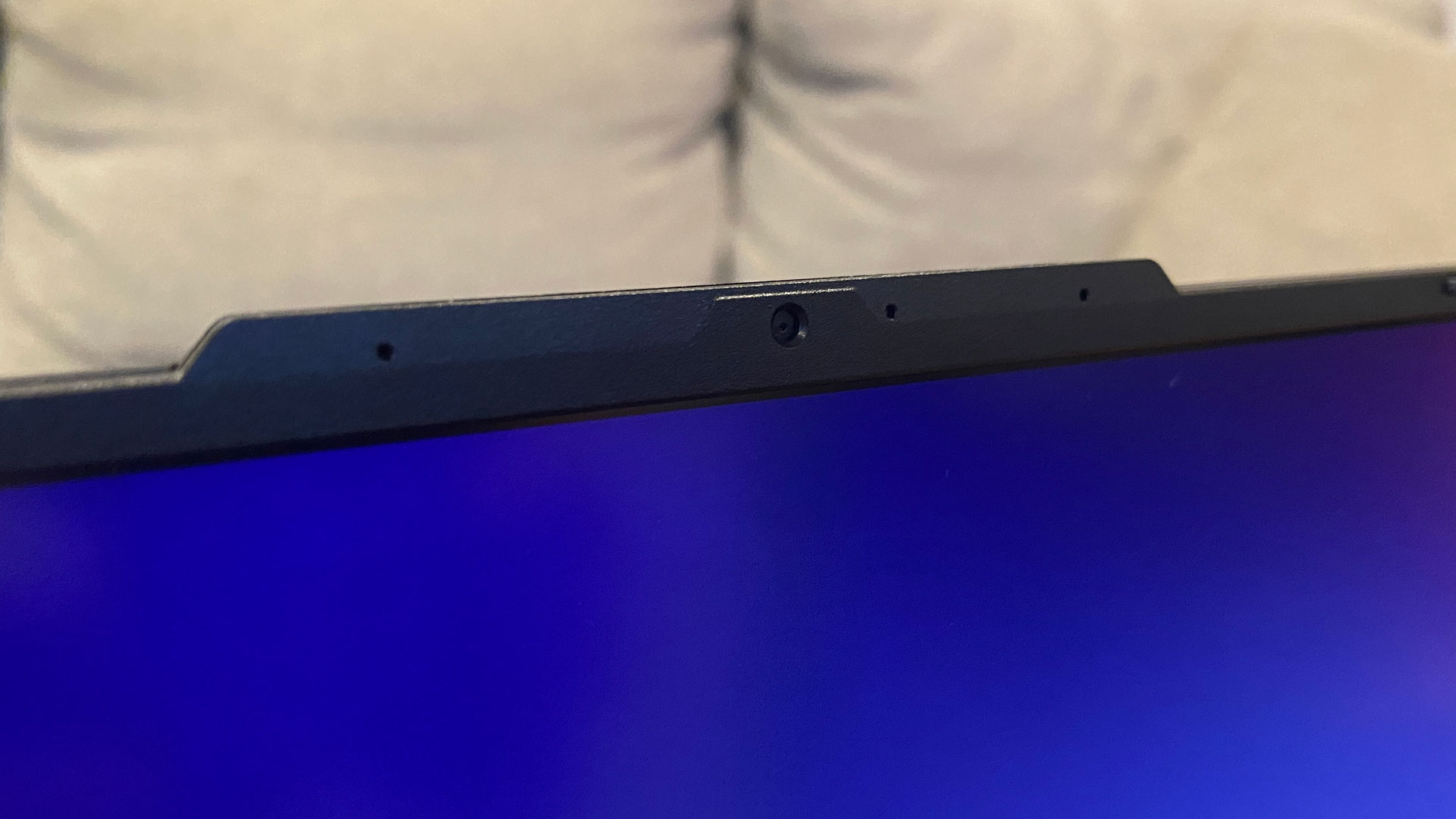
And in this case, the image quality wasn't great! Using the webcam at my desk at home, the image appeared cool, with a burgundy t-shirt looking almost purple. My skin was smudgy and my beard and hair looked muddy. I wouldn't want to look like this on a stream. If you're replacing the rest of your desktop, you might as well invest in one of the best webcams, too.
Software and Warranty on the Asus ROG Strix Scar 18
Asus has a bunch of software preinstalled. Some of it, like Armour Crate and Aura Creator, are useful. Armoury Crate is a one-stop shop for component statistics, settings profiles and lighting. Aura Creator has more advanced RGB lighting effects. Our Scar 18 review sample wasn't working with the lighting software when we tried it but presumably, that will be updated.
There's also some bloat. Virtual Pet, which I've seen on Asus' G14 line before, is effectively a more advanced Tamagotchi that lives on your desktop. (The G14 can also show it on the lid with LEDs. The Scar cannot). It doesn't have the games or other functions the G14's pet does. I opened it once and closed it forever.
Then there's MyAsus, which is functional as a place to check your serial number and warranty information, but I don't see anyone checking it regularly.
There is also the usual Windows 11 software in the Start Menu, including WhatsApp, Spotify and TikTok. Antivirus came in the form of a trial of McAfee Live Safe.
Asus sells the Strix Scar 18 with a 1-year warranty.
Asus ROG Strix Scar 18 Configurations
We tested the Asus ROG Strix Scar 18 with an Intel Core i9-13900HX, Nvidia GeForce RTX 4090, 32GB of RAM and 2TB of PCIe Gen 4 SSD storage, which costs $3,899.99.
On Best Buy, there's a cheaper model with a Core i9-13980HX, Nvidia GeForce RTX 3080, 16GB of RAM and 1TB of storage for $2,499.99.
Bottom Line
The Asus ROG Strix Scar is big. It's really, really big. With that comes room for some seriously powerful components, and the Intel Core i9-13980HX and Nvidia GeForce RTX 4090 deliver some serious might.
Asus has also delivered a bright, colorful display and loud speakers that sound great while watching movies or playing games. That being said, the MSI Titan GT77 HX's screen is even brighter, and higher resolution. And as we noted in the gaming performance section, Nvidia’s RTX 4090 graphics really is better suited to 4K than 1660p.
If you want an 18-inch, 16:10 screen, the Strix is the way to go. But if you prefer the classic 16:9 aspect ratio in a 17-inch panel and want to go up to 4K, you may want to consider the Titan.
These parts are designed for someone who wants to get the maximum they can out of a mobile gaming rig. If you don't play the most intense games at their highest settings, there are better, cheaper options. In most cases, we got some pretty strong performance out of the Strix Scar, though I imagine some driver refinements will also help in a few questionable spots.
The Strix Scar can, in many ways, replace your desktop. If you have a small apartment with no room for a monitor, or you just want to be able to carry your PC from room to room, the Scar 18 is an expensive, competent option.
MORE: How to Buy a Gaming Laptop
MORE: Best Gaming PCs
MORE: Best Ultrabooks and Premium Laptops

Andrew E. Freedman is a senior editor at Tom's Hardware focusing on laptops, desktops and gaming. He also keeps up with the latest news. A lover of all things gaming and tech, his previous work has shown up in Tom's Guide, Laptop Mag, Kotaku, PCMag and Complex, among others. Follow him on Threads @FreedmanAE and BlueSky @andrewfreedman.net. You can send him tips on Signal: andrewfreedman.01


